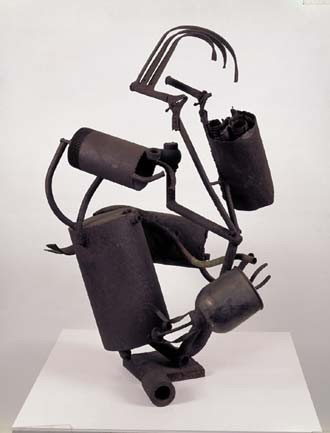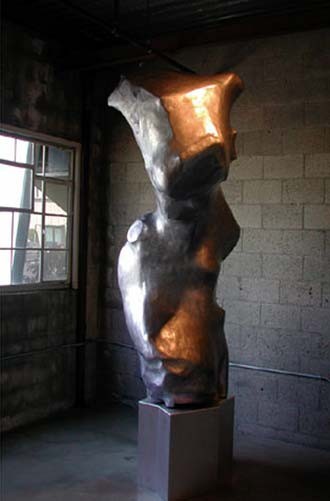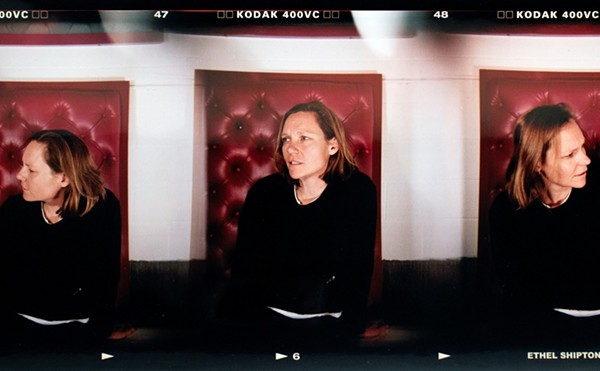|
By Elaine Wolff "Clumsy, graceful, safe, threatened, heroic, pathetic, svelte, chubby, serious, silly, volatile, calm," goes a list of adjectives used in ArtForum to describe emotions evoked by the sculpture of young up-and-comer Joel Morrison. Morrison's pieces, which range from the size of a large human head to a small bull elephant, are composed of found objects, including metal armatures, boxes, and gas masks, bound with packing tape and Saran Wrap, and encased in fiberglass. Finesilver Gallery operator Chris Erck is especially enamored of the work, which he and many others see as reinvigorating formalist sculpture by redeeming the use of the figure. The pieces - some of which are Fiberglass castings of the original sculptures, some finished in treacly enamel colors or the pastel palette of Bondo - conjure images of gawky fowl, lumbering mammals, and torqued classical torsos. LA Times art critic Christopher Knight penned the most quotable quote on Morrison's kinetic blobs: " ... like cats in a sack - animated, barely controlled chaos." The cranky blogger of the Sacramento Art Project begs to differ: "I personally found the sculptures somewhat boring," s/he sniffed. These widely differing opinions of work that is clearly worth talking about - whatever one's final pronouncement - also characterize the recently resurrected reputation of junk-metal sculptor Richard Stankiewicz. Miracle in the Scrap Heap, the first major retrospective of this influential midcentury artist, on view at the McNay through July 11, reveals a body of work that is formal in its conception and construction, but avant-garde in its use of materials and choice of subject matter. His engaging, quirky figures and contraptions are composed entirely of corroded metal detritus - fly wheels, chains, boilers - but they are exquisitely balanced and resolutely human in scale and content. While the use of revolutionary materials places him squarely in the post-World War II era, his adherence to narrative and the integrity of form tether his work to the rigor of High Modernism, notes the handsome book accompanying this exhibit. Stankiewicz, a contemporary of Jasper Johns and Robert Motherwell, among others, was the quintessential 20th-century American. The child of Polish immigrants, he grew up playing on slag heaps near railroad tracks in Detroit, fought in World War II, and built a first-class arts education on the GI Bill. His father was killed by a train when he was a toddler, and he was raised by a physically violent stepfather.
Stankiewicz was part of the "vitalist" tradition that imbued art with a life of its own (eyes meet those of the viewer in most of his sculptures), distinct from postmodern artists, whose transposition of objects often addresses a sense of alienation and dissatisfaction with the unmet promises of late industrial society. The abiding benevolence of Stankiewicz' creatures speak of a faith in the potential of the individual and in the integrity of Western culture that began to erode in the shadow of the Holocaust, was further deconstructed in the counterculture of the '60s and '70s, and is only now regaining credence in the art world. Some of the fragments that Stankiewicz salvaged for his sculpture were on the brink of obsolescence: shoe lathes and hand cranks. Others were just entering their primacy: gas tanks and crude mufflers. But all of the pieces are corroded to near unrecognizability, elevating Stankiewicz' compositional brilliance and plaintive humanity over the whimsy artificially preserved in the lacquered "Middle-Aged Couple."
Stankiewicz is Morrison's direct predecessor in embracing our common humanity from a mostly subjective standpoint: he was a first step toward the era of Oprah; Morrison signals a desire to return to something grander and more universal than our personal anomie. The humor and ambivalence of continuing to find hope, pleasure, and even vision, in a world in which our detritus far outweighs our beneficial production, shines through both men's work. But it doesn't always make your blood race faster. • By Elaine Wolff
|

















